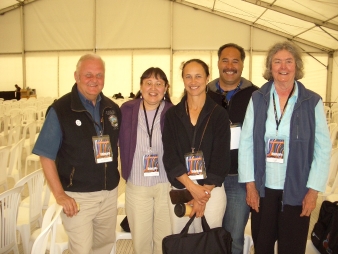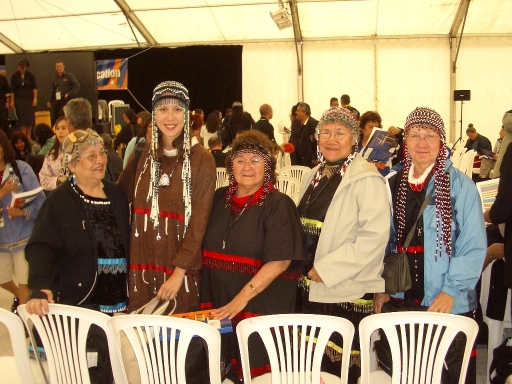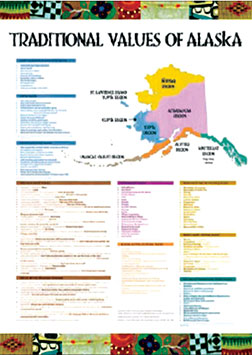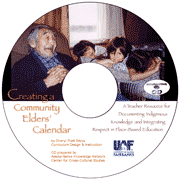|
Sharing Our
Pathways
A newsletter of the Alaska Native Knowledge Network
University
of Alaska Fairbanks
Volume 11, Issue 1, Winter/Spring 2006

In This Issue:

WIPCE 2005 hosted by the Maori!
by Ray Barnhardt
 The 7th tri-annual World Indigenous Peoples Conference
on Education was held in Hamilton, New Zealand on Nov. 26 – Dec.
1, 2005. The Maori people set a new standard for hospitality in
hosting
over 3000 conference attendees in true Maori fashion, including
a day-long welcoming ceremony at a "marae" on the banks
of the Waikato river and over 400 workshops held on the campus
of the University of Waikato. Alaska was well represented with
nearly 100 attendees, including large delegations from the NANA
region, the North Slope and Juneau,
each of which performed at the opening ceremony. The workshops
addressed a wide range of issues organized around Indigenous
leadership, language revitalization, Indigenous research and new
horizons in
Indigenous education. The inspirational keynote addresses presented
each day were made available to conference participants in the
form of a copy of the first issue of a new International
Indigenous Journal (available at http://www.indigenousjournal.com/).
Attendees were also able to participate in field trips to visit
various
Maori communities and education initiatives. For those who had
visited
Aotearoa (New Zealand) in the past, WIPCE provided a great opportunity
to reconnect with old friends and catch up with all the exciting
things that are happening in Indigenous education around the
world. The 7th tri-annual World Indigenous Peoples Conference
on Education was held in Hamilton, New Zealand on Nov. 26 – Dec.
1, 2005. The Maori people set a new standard for hospitality in
hosting
over 3000 conference attendees in true Maori fashion, including
a day-long welcoming ceremony at a "marae" on the banks
of the Waikato river and over 400 workshops held on the campus
of the University of Waikato. Alaska was well represented with
nearly 100 attendees, including large delegations from the NANA
region, the North Slope and Juneau,
each of which performed at the opening ceremony. The workshops
addressed a wide range of issues organized around Indigenous
leadership, language revitalization, Indigenous research and new
horizons in
Indigenous education. The inspirational keynote addresses presented
each day were made available to conference participants in the
form of a copy of the first issue of a new International
Indigenous Journal (available at http://www.indigenousjournal.com/).
Attendees were also able to participate in field trips to visit
various
Maori communities and education initiatives. For those who had
visited
Aotearoa (New Zealand) in the past, WIPCE provided a great opportunity
to reconnect with old friends and catch up with all the exciting
things that are happening in Indigenous education around the
world.
 Just prior to the WIPCE events, the World Indigenous
Nations Higher Education Consortium held its annual meeting of
representatives
from the many Tribal Colleges, Maori wananga and other First
Nations
institutions from around the world, including the Consortium
for Alaska Native Higher Education. In addition to reviewing
several
new Indigenous-serving programs and institutions as candidates
for WINHEC accreditation, the executive board introduced the
WINHEC Journal and enacted a variety of initiatives to strengthen
Indigenous
higher education on an international scale. For details about
the WINHEC Journal and other WINHEC activities, go to http://www.win-hec.org. Just prior to the WIPCE events, the World Indigenous
Nations Higher Education Consortium held its annual meeting of
representatives
from the many Tribal Colleges, Maori wananga and other First
Nations
institutions from around the world, including the Consortium
for Alaska Native Higher Education. In addition to reviewing
several
new Indigenous-serving programs and institutions as candidates
for WINHEC accreditation, the executive board introduced the
WINHEC Journal and enacted a variety of initiatives to strengthen
Indigenous
higher education on an international scale. For details about
the WINHEC Journal and other WINHEC activities, go to http://www.win-hec.org.
The
next World Indigenous Peoples Conference on Education will be
hosted by the Australian Aboriginal people in Melbourne,
Australia in 2008. Stay tuned for further details and plan
on attending.

Alutiiq Delegation

Equal education means equal results
By Diane Hirshberg
(Published: January 27, 2006 in the Anchorage Daily News, permission
to reprint from the author)
The Alaska Constitution placed responsibility
for providing a public education to all children squarely in the
hands of the state Legislature.
This year's 50th anniversary of the Constitutional Convention provides
a good opportunity for citizens to reflect on the constitution's
influence over education and to learn a bit about the history of
public education in our state.
The constitution directs the Legislature
to "establish and
maintain a system of public schools open to all children of the
state." For the first 17 years of statehood, Alaska's education
system was anything but open to all.
There were, instead, two systems
of public schooling in place: one for non-Native and Native children
living in urban communities
and another for Native students in rural villages. While children
in urban areas enjoyed access to state-funded public schools from
kindergarten through 12th grade, most Native students in rural
communities attended primary schools operated either by the Bureau
of Indian Affairs or missionaries. Native teens in rural areas
had no access to secondary education in their home communities
and were forced to choose between attending a boarding school or
living in a boarding home while attending school in an urban area.
In 1972 a lawsuit challenged the constitutionality
of the state's secondary school system for rural Alaska Natives.
The case, commonly
known as "the Molly Hootch case," was settled by the
Tobeluk v. Lind consent decree in 1976, with the state agreeing
to construct local high schools throughout rural Alaska.
Now that
the state has taken responsibility for educating all children,
Native and non-Native alike, there still remains the question of
whether this is enough. Does the state need to do more than simply
open schools wherever children reside?
The answer to that question
is provided in Article I, Section 1, where the constitution states "all
persons are equal and entitled to equal rights, opportunities,
and protection under the law." Under
this "equal protection clause" the state must provide
an equal education to all students, regardless of race.
But what
does this mean? Is it making sure all schools receive the same
per- pupil funding, with just some adjustments to school
funding based on different costs in rural Alaska? Or is there
another way we should look at equality in education?
The federal
government tells us, via No Child Left Behind, that schools must
bring all groups of students to acceptable levels
of achievement. If we take that as a guide, then we need to
look at education outcomes, rather than inputs, as our measure
of
equality.
Creating equal educational opportunities does not
mean simply providing exactly the same access and resources to
all children
across the
state. Instead, it means creating conditions under which
all children can achieve to a high standard. Often, people argue
that equality
of opportunity is achieved by providing identical resources
to students within the classroom. However, equality of inputs
does
not always result in equitable outcomes for all students. In
Alaska, there is a significant gap between the achievement of
Native and non-Native students, and despite No Child Left
Behind,
it does not appear to be narrowing. We need to look for different
approaches to meeting the needs of all students in order
to erase this gap.
Students come to school with different levels
of preparedness and resources on which to draw. However, their
ability to
learn and
achieve is not dictated by these factors. Educators can
and should teach all children so that they reach high levels
of competency
across subjects and so that they develop both a lifelong
love of learning and a desire to be informed and engaged
citizens
within
their local and state community.
Additional resources are
needed in those schools serving students who lack basic skills
when they enter school.
A concentrated
investment early on in the education of those children
most in need of extra
help -- whether urban or rural, Native or non-Native
-- will lead to much more equitable outcomes in the long run.
If
our goal is
equality of opportunity for all students in Alaska, then
we must do no less.
Diane Hirshberg is an assistant professor
of education policy at the University of Alaska Anchorage. More
information
about
the
Alaska Constitution can be found at http://www.alaska.edu/creatingalaska.

Dr. Graham Smith at UAF
Graham Smith, a distinguished Maori professor from the University
of Auckland and the University of British Columbia, spent three
weeks in February at UAF at the invitation of the the Chancellor's
Advisory Committee for Native Education (CACNE) to explore the
development of a support structure and pathway for attracting
more Alaska Natives to pursue a PhD in their field of interest.
Following is the introductory section of a preliminary report
that he has prepared for discussion purposes. He will return
to UAF in April to follow up on his initial work and begin identifying
potential candidates for a cohort of graduate students at each
of the UA campuses. If you have any interest in this initiative,
please get in touch with Bernice Joseph, Dean of the College
of Rural and Community Development and Chair of CACNE. Bernice
can be reached at <bernice.joseph@uaf.edu>
A ‘Think
Piece’ Report on Developing Graduate Programming
to Impact Native and Rural Community Underdevelopment.
Distinguished
Professor Graham H. Smith, PhD
1. Preamble
The intention of
this ‘think-piece’ is to
consider positive and proactive ideas and strategies that will
enhance graduate program development within the University of Alaska – Fairbanks
(UAF). In particular to develop a suite of initiatives that are
potentially more responsive and inclusive of Alaskan native and
Indigenous students on the one hand and responsive to wider Alaskan
native community (ies) learning needs and aspirations on the other.
The transformative model that is being used responds on two planes
- a vertical axis (indigenous needs focus) and a horizontal axis
(the institution as a whole focus). Both elements need to be developed
simultaneously with mutual regard of each others interests and
adhering to an overarching concern to build an excellent research
University site that is responsive and inclusive of its obligations
to the State of Alaska as a whole.
There are several assumptions
upon which this Report is predicated. There is a need to;
- embrace
an approach to transformation that
is alluded to in the refrain from the movie ‘The Field
of Dreams’. It neatly encapsulates what needs to occur
in many institutional environments including UAF. Thus the saying
- ‘build
it and they will come’; has resonance with the fact
that if an institution creates an environment, courses and pathways
that are relevant, culturally affirming, and genuinely excite
indigenous students; indigenous students will come. If Faculties
or individuals
create innovative and outstanding indigenous initiatives that
have relevance, funding will find the projects – but there
is a need to first build something and if the idea is good enough
it will attract funding support. An institution often needs to
consider making a commitment to investing at the front end as
well
and not always waiting and raising funds on ‘intentions’ and ‘promises’.
This is a call to also get proactive with some initiatives and
not wait for external funding – you can also ‘back – fill’ with
external funding.
- move from a reactive mode to a more proactive
and development mode
- encourage the development of a State wide
policy forum on Native higher education given the need to co-ordinate
more efficiently
the few resources available across the State; this might come
from
a statewide indigenous group such as AFN or it could come from
the First Alaskans Institute or both.
- ‘risk-manage’[1]
the institutional processes given the current back-lash against
affirmative action and race based
programming.
- Pre-empt through a planning process the strategic
growth of Native students at undergraduate and masters levels
across the
Faculties
- employ multiple strategies for transformation in
multiple sites and to move beyond the ‘one size fits all’ assumption
- initiate a ‘whole of institution’ response; that
is, initiate a shift away from the traditional institutional
models designed to respond to Native interests which create ‘single
departments’ and ‘one of’ initiatives and which
sometimes have the effect of putting indigenous interests into
a ‘corner’ of the institution. The new approach that
is being taken up by the most successful institutions in responding
to indigenous developments is the move to a ‘whole of institution’ approach.
This requires everyone and every sector in the institution to
be responsive and inclusive of indigenous needs.
- assume that
institutional leaders will lead; the transformation expectations
are delegated down the leadership chain. In University
institutions, because resources are usually decentralized to
Faculties, senior Management will need to require Deans and Faculties
to move
proactively in these areas.
- presume that many of the proposed
strategies for the redevelopment of Indigenous success in UAF
can be achieved without new funding
through a re-configuration of existing resources and priorities.
However, there will also be a need for some additional funding
either from internal or external funding sources – although
it is anticipated that many of the proposed initiatives can be
simply enacted through policy inclusion and accountability.
- acknowledge the necessity in the UAF to “grow our own” doctoral
graduates. This strategy has two thrusts; First; taking institutional
responsibility to grow Native graduates within the University
of Alaska (and not necessarily exporting all of them elsewhere);
Second;
enhancing the credentials of the existing Native Faculty base
into doctoral qualifications where and as appropriate. (The institution
should simultaneously (by asking Deans to move proactively in
increasing
their capacity and capabilities in respect of Alaskan Native
research and teaching, and to move proactively to also attract
new staffing
in these areas, including more Native Faculty from outside the
institution who are appropriately qualified)
2. The Aims of this
Report
This Report is made to the Chair of the CACNE. The
Chair has undertaken to continue the consultation process as required,
to continue to
build the formal response, and to promulgate various components
to the required committees and individuals.
- Consider the
strengths and weaknesses of the existing approaches to Native
graduate development at UAF and where appropriate
to suggest strategies for improving the responsiveness
of UAF. (to
be developed through the Chancellor and the Provost)
- Provide a critical overview and potential strategies to enable
a specific Doctoral pathway to be developed that will
focus on
producing transformative outcomes for Native Education.
(to be taken through the Dean of Graduate Studies when ready)
- Develop an integrated approach across the UA system and across
the various institutions to Native Higher Education
in general
and to Native graduate development in particular. (to
be developed through the Chancellor and the Provost and State
wide committee
structure)

 Traditional Values of Alaska Poster Traditional Values of Alaska Poster
(produced by Association of Alaska School
Boards)
The cultural belief
and traditional value systems that helped educate and mold
generations of Alaska Natives years ago are just as valid
and relevant today. The values listed - simple, genuine and insightful
- illustrate the core beliefs of the diverse cultural groups
that make up our great state. More than that, by collecting the
traditional
values of each tribe and presenting them in one place, we highlight
the common ground and humanity that ties them together.
Price:
Free
For ordering information, go to:
http://www.aasb.org/Bookstore/BooksA_B.html

13th Annual Stabilizing Indigenous Languages
Symposium
2006 SILS Conference Theme
"And Together Our Minds Are One"
Buffalo State College
State University of New York
1300 Elmwood Avenue
Buffalo, New York USA
May 18-21, 2006
Information may be found at:
http://www.buffalostate.edu/elementaryeducation/sils.xml

UAF Cross-Cultural Studies Summer Classes
Field Study Research Methods
CCS F603 - F41 3 credits
CRN 50709 Staff
8:30 a.m. - 12 p.m., MTWRF, U Park 150 June 26 - July 14
Focus on considerations and techniques for conducting field research
in a cross-cultural setting, with particular attention to participatory
approaches and naturalistic research designs. Students must have
access to a field setting in which to conduct a research project.
Prerequisite: ED 601. Crosslist: ED F603-F41.
Indigenous Knowledge
Systems
CCS F608 - F41 3 credits
CRN 50708 Kawagley
8:30 a.m. - 12 p.m., MTWRF, U Park 102 June 26 - July 14
Comparative survey and analysis of the epistemological properties,
world views and modes of transmission associated with various indigenous
knowledge systems. Emphasis on knowledge systems practiced in Alaska.
One day field trip to Athabascan Elder Howard Luke’s Gaalee’ya
Spirit Camp on the Tanana River. Prerequisite: Graduate standing
or permission of instructor. $41 field trip fee.
Education and Cultural
Processes
CCS F610 - F31 3 credits
CRN 50711 R. Barnhardt
9 a.m. - 12 p.m., MTWRF, U Park 150 June 5 - 23
Advanced study of the function of education as a cultural process
and its relationship to other aspects of a cultural system. Prepare
a study and examination of some aspect of education in a particular
cultural context.
Note: Meets State of Alaska initial teaching certificate requirement
in multicultural/cross-cultural communication. Crosslist: ED
F610-F31.
For more information, visit the UAF Cross-Cultural
Studies website at:
http://www.uaf.edu/cxcs/

New CD-ROM "Creating a Community Elder's Calendar"
 Cheryl Pratt Silcox provides a teacher resource
manual for documenting Indigenous Knowledge and integrating respect
in place-based education.
The chapters include: Cheryl Pratt Silcox provides a teacher resource
manual for documenting Indigenous Knowledge and integrating respect
in place-based education.
The chapters include:
I Teaching with Tradition
II Making Sense of Place
III Positive Protocols
IV Reliable Resources
V Enriching with Elders
VI Creating Comfort
VII Putting it All Together
The CD-ROM is available through the
Alaska Native Knowledge Network Publications Department <uaf-cxcs@alaska.edu> --
(907) 474-1902. Cost for each CD is US$1 plus shipping, covering
the
cost to reproduce this resource.

ANKN Curriculum Corner
Arctic climate curriculum geared for rural students
by
Amy Hartley, Geophysical Institute
http://www.uaf.edu/news/featured/06/acmp/
"Sea ice cover is decreasing, lakes are drying up, ecosystems are
changing and thawing permafrost is creating changes in water supply.
For residents living in Northwestern Alaska, life has become quite
different from what it was years ago. "The Arctic Climate Modeling Program [http://www.arcticclimatemodeling.com/],
a teacher training and curriculum development project designed
at the University of Alaska Fairbanks, aims to equip 1,700 students
from the region with the math, science and technology skills they
need to better understand their changing surroundings. The project
offers a progression of learning for K-12 students, helping 165
teachers in the Bering Straits School District guide them to think
like scientists, learn the basics of arctic climate and then ultimately
analyze the data and work with current research in the field of
climate change.
"The innovative curriculum is brand new, but already teachers and
developers say that ACMP's format works well for rural students.
Hands-on activities, practical use of equipment and involvement
with one's own community provide a curriculum finely tailored to
village life."
UAF Science Education Outreach Network:
http://www.uaf.edu/outreach/clearinghouse/index.html
"The University of Alaska Fairbanks offers much
more than academic degree programs and scientific research.
"UAF science departments and research units at UAF sponsor education
outreach programs or activities that range from providing judges
and school tours of research facilities, to K-12 curriculum development
to college-bridging programs and science camps, to free workshops
provided in communities across Alaska, and more.
"Until now, these efforts have occurred independently of each other.
No overall list of activities existed, and little coordination
among departments occurred. With support from science departments
and research units across campus, the UAF Science Education Outreach
Network was developed to unite these efforts.
"The UAF Science Education Outreach Network is a searchable database
of the science education outreach programs and resources available
through UAF. K-12 students and teachers, UAF college students
and community members around the state can search the database for
activities and resources available. Programs are searchable by
categories such as calendar date, science discipline, Alaska
region and Alaska Native culture.
"Please take time to browse through the UAF
Science Education Outreach Network and let us know what you think."
For
more information, you may contact the UAF Science Education Outreach
Network Coordinator at 907-474-7999 or scienceoutreach@uaf.edu.
 Here
are some upcoming themes for future eSOP's: Here
are some upcoming themes for future eSOP's:
- Native Language Resources
- Reports for Alaska Native Educator
Associations
- Academies of Elders
If you have any contributions for these or other
eSOP themes, please send them to the eSOP Newsletter Editor <sop@ankn.uaf.edu>.

Alaska Native Knowledge Network Contacts
Ray Barnhardt
University of Alaska Fairbanks
ANKN
PO Box 756730
Fairbanks, AK 99775-6730
(907) 474-1902 phone
(907) 474-5208 fax
email: ffrjb@uaf.edu
Oscar Kawagley
University of Alaska Fairbanks
ANKN
PO Box 756730
Fairbanks, AK 99775-6730
(907) 474-5403 phone
(907) 474-5208 fax
email: oscar@ankn.uaf.edu
|
Jeannie
Creamer-Dalton
University of Alaska Fairbanks
ANKN
PO Box 756730
Fairbanks, AK 99775-6730
(907) 474-1902 phone
(907) 474-5208 fax
email: jeannie@ankn.uaf.edu
Paula
Elmes
University of Alaska Fairbanks
ANKN
PO Box 756730
Fairbanks, AK 99775-6730
(907) 474-7174 phone
(907) 474-1957 fax
email: paula@ankn.uaf.edu Sean Topkok
University of Alaska Fairbanks
ANKN
PO Box 756730
Fairbanks, AK 99775-6730
(907) 474-5897 phone
(907) 474-1957 fax
email: sean@ankn.uaf.edu
|
is a publication of the Alaska Native Knowledge
Network through the University of Alaska Fairbanks.
We welcome your comments and suggestions and encourage
you to submit them to:
The Alaska Native Knowledge Network
Old University Park School, Room 156
University of Alaska Fairbanks
P.O. Box 756730
Fairbanks, AK 99775-6730
(907) 474-1902 phone
(907) 474-1957 fax
Newsletter Editor: Sean Topkok
Layout & Design: Paula
Elmes
 Up
to the contents Up
to the contents
|